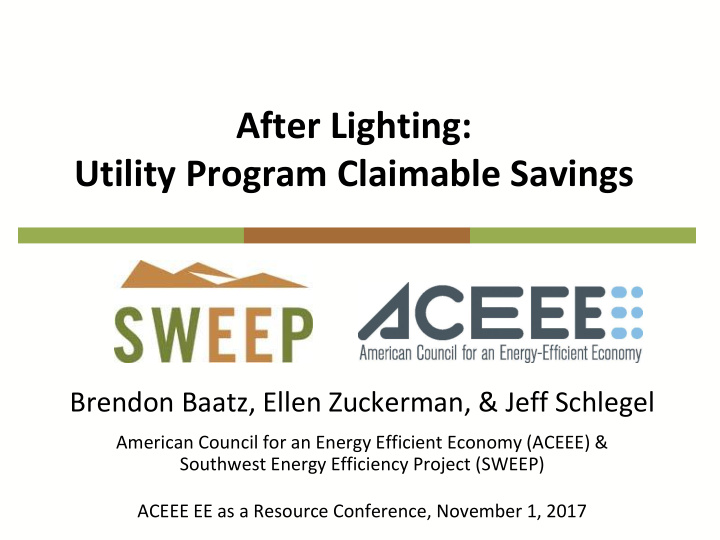



After Lighting: Utility Program Claimable Savings Brendon Baatz, Ellen Zuckerman, & Jeff Schlegel American Council for an Energy Efficient Economy (ACEEE) & Southwest Energy Efficiency Project (SWEEP) ACEEE EE as a Resource Conference, November 1, 2017
Introduction • Not going to comment on status or forecast of lighting market, or transition to the future • Provide a little data on how important lighting has been to EE programs • Highlight a few issues, challenges, and opportunities • Thanks to co-authors and colleagues in other states for contributions
Lighting has been a major contributor to program lifetime savings in many states % of Residential Electric Lifetime Savings from Residential Lighting 100% % of Savings in Residential Sector 90% 81% 79% 78% 80% 70% 66% 62% 60% 60% 60% 58% 56% 60% 55% 54% 50% 40% 30% 20% 10% 0% 2013 2014 2015 2016 Massachusetts Arizona (APS) Minnesota (Xcel) Source: Arizona Public Service (APS) Company Annual Demand Side Management Reports, 2013-2016; Xcel Energy Status Report & Associated Compliance Filings Minnesota Electric and Natural Gas Conservation Improvement Program, 2013-2016; Massachusetts Energy Efficiency Advisory Council, “New Approaches in the Face of Rising Baselines and Other Trends: Challenges and Innovative Options,” Sept. 21, 2017 .
The importance of lighting to C&I programs Source: Optimal Energy analysis for Massachusetts Energy Efficiency Advisory Council, C&I Workshops
Society will still receive savings from lighting; savings just won’t be “claimable” by programs • Evolution of the market means that businesses and residents will continue to reap the savings and benefits of efficient lighting – which is a success story. • However, federal standards and market developments (which impact net-to-gross ratios) mean utilities will not be able to claim program savings from lighting.
There will still be lighting opportunities in programs – program-claimable savings • Residential: ■ Hard-to-reach customers and market segments ■ High lumen and specialty products ■ Lighting opportunities in the near-term (to ~2020) ■ Early replacement of lighting • C&I ■ Better lighting products and systems still needed ■ Solid state lighting opportunities, especially with the integration of controls and DR capabilities • How to guard against a premature exit from the markets/technologies while avoiding unnecessary support for already transformed markets/technologies
California potential study – Residential Source: Energy Efficiency Potential and Goals Study for 2018 and Beyond. Prepared for the California Public Utilities Commission. September 25, 2017.
California potential study – Commercial Source: Energy Efficiency Potential and Goals Study for 2018 and Beyond. Prepared for the California Public Utilities Commission. September 25, 2017.
One challenge for residential programs: on-site program delivery approaches • Program delivery approaches will also be impacted. • Will programs pencil out for cost-effectiveness? • Will programs remain a viable business opportunity for contractors? Image Source: Massachusetts Energy Efficiency Advisory Council
Source: “No lighting” assumption made solely as one scenario for analysis, for the purposes of assessing potential impacts on one end of spectrum; for discussion by Massachusetts Energy Efficiency Advisory Council
New approaches: new measures and strategies Co-delivery • Electric & natural gas integrated programs ■ Water efficiency ■ Health services ■ Resiliency ■ Rate education ■ Fuel switching/electrification • Active demand management, new measures • Storage • Electric vehicles • Solar PV co-delivery • Utility support of codes & standards adoption, implementation • New funding sources (i.e. health insurance/services) • New approaches for evaluating cost effectiveness •
EE Programs vs. Co-Delivered and Co-Funded EE Programs Co-Delivery and Co-Funded EE Policy Framework EE Policy Water Savings Framework Policy Framework Coordinated Delivery of EE and Water Savings Programs Programs EE Funded Water Funded Contractor Energy Savings and Demand Energy Water Benefits Savings and Savings Demand Benefits Benefits 12 Jeff Schlegel and Optimal Energy, on behalf of Massachusetts Energy Efficiency Advisory Council
Value Propositions Bringing Commercial Real Estate into the Internet of Things. Demand management and grid services Source: Carol Jones, Enlighted; presentation at Design Lights Consortium Stakeholder Meeting, July 2017
What motivates customers & action? Where is the value? Presentation Title $3 $300 $3000 $30 RENT EMPLOYEE BUSINESS UTILITY Cost per ft 2 Cost per ft 2 Revenue per ft 2 Cost per ft 2 Proprietary and Confidential Source: Alex Do, Acutity Brands; presentation at Design Lights Consortium Stakeholder Meeting, July 2017 (Several people have used the 3/30/300 analysis)
NWPCC 7 th Power Plan (2016) Source: Northwest Power and Conservation Council. Seventh Northwest Conservation and Electric Power Plan. 2016.
Contact Information • Brendon Baatz BBaatz@aceee.org • Jeff Schlegel schlegelj@aol.com 520-907-1088 (m) • Ellen Zuckerman ezuckerman@swenergy.org 609-610-2989 (m)
Recommend
More recommend